Occupational Safety Training for Automatic Foam Pouring Machine Operation
99,000 ₫
Note: The above price is calculated for one person and may vary depending on the number of trainees participating in the course and market fluctuations. For more accurate pricing support, please refer to the price list or contact our consulting staff directly.
Occupational safety is an important issue when operating an automatic foam pouring machine and must be addressed promptly to ensure the health and safety of workers as well as enhance the reputation of businesses here. The Occupational Safety Training course is one of the effective solutions to raise awareness on preventing occupational accidents for workers when operating automatic foam pouring machines.
Table of Contents
Toggle1. Overview of Automatic Foam Pouring Machines
a. What is an automatic foam pouring machine?
An automatic foam pouring machine is equipment used to automate the process of pouring polyurethane foam or other types of foam into molds or desired products. This equipment is commonly used in manufacturing industries to create foam products such as mattresses, pillows, or insulation components.
Benefits:
- High Efficiency: Increases productivity and reduces production time compared to manual methods.
- Consistent Quality: Ensures uniform product quality thanks to precision in mixing and pouring foam.
- Cost Savings: Reduces labor costs and minimizes material waste.
Applications:
- Mattress and Pillow Production: Pouring foam into molds to produce various types of mattresses and pillows.
- Insulation: Producing insulation components for the construction and automotive industries.
- Packaging: Providing protective packaging solutions for sensitive products.
The automatic foam pouring machine is an essential tool in the foam industry, helping to enhance production efficiency and improve product quality.

b. Operating principle of the automatic foam pouring machine
Material Preparation
- Chemical Materials: Automatic foam pouring machines use chemical components to produce polyurethane foam or other foams. The main components typically include isocyanate and polyol, along with additives such as foaming agents, stabilizers, and flame retardants.
- Material Storage: These materials are stored in separate containers connected to the machine via pipelines.
Mixing Materials
- Mixing System: The machine is equipped with an automatic mixing system to blend the chemical components at precise ratios. The system often includes agitators or mixers to ensure the components are evenly mixed.
- Ratio Control: The ratio between chemical components is adjusted via valves or metering pumps to achieve the desired foam quality.
Pumping and Pouring
- Material Pumping: After mixing, the foam mixture is pumped through pipelines to molds or desired shapes. The pumping system is typically adjusted to control the flow rate and pressure of the foam mixture.
- Foam Pouring: The machine may be equipped with flexible pouring heads to distribute the foam mixture into different molds or shapes. The pouring process can be adjusted to ensure even and precise foam distribution.
Temperature and Time Control
- Temperature Control: The temperature of the foam mixture and molds is often monitored and adjusted to ensure proper curing. The machine may have temperature sensors and cooling or heating systems to adjust the temperature.
- Curing Time: The time required for the foam to solidify can be automatically controlled, usually based on the technical specifications of each foam type. The machine may use timers or sensors to adjust curing time.
Finishing and Processing
- Cutting and Processing: After the foam has cured and meets quality requirements, the product can be cut or further processed to achieve the final size and shape. Some automatic foam pouring machines can integrate these steps into the process.
- Quality Inspection: The machine often has quality control systems to ensure the final product meets durability, uniformity, and other specifications.

c. Industries that use automatic foam pouring machines
Mattress and Pillow Manufacturing Industry
- Mattresses and Pillows: Automatic foam pouring machines are used to produce mattresses and pillows by pouring polyurethane foam into molds of various shapes and sizes. Automation ensures consistent quality and minimizes production errors.
Automotive Industry
- Soundproofing and Insulation Components: In the automotive industry, foam pouring machines are used to create soundproofing and insulation parts for vehicle cabins, such as soundproof panels and protective components.
Packaging Industry
- Packaging Materials: Automatic foam pouring machines can produce protective foam layers in the packaging industry to safeguard sensitive goods during transportation. These foam layers help reduce the risk of damage and impact.
Construction Industry
- Insulation and Soundproofing: In construction, foam pouring machines are used to produce insulation and soundproofing materials such as insulation panels and acoustic components for buildings.
Furniture Industry
- Furniture Products: Automatic foam pouring machines are used to produce furniture items such as sofas, seat cushions, and other upholstery, providing comfort and support for users.
Toy Manufacturing Industry
- Foam Toys: Foam pouring machines are also used in toy manufacturing to create foam toys, allowing for the shaping and design of soft and safe products for children.
Medical Industry
- Medical Mattresses: In healthcare, automatic foam pouring machines are used to produce medical mattresses such as anti-bedsore mattresses and support cushions for patients, improving comfort and support during treatment.
Sports and Entertainment Industry
- Sports Equipment: Foam pouring machines are also applied in the production of sports and recreational equipment, such as protective pads and sports support devices.
2. Overview of Safety Training for Operating Automatic Foam Pouring Machines
a. What is occupational safety training?
- Occupational safety training for operating automatic foam pouring machines consists of lessons that equip workers with awareness of how to prevent workplace accidents. Workers who operate directly with automatic foam pouring machines fall into Group 3.
- The safety training course will help workers identify and avoid hazards, reducing the risk of workplace accidents during work.
REGISTER FOR OCCUPATIONAL SAFETY TRAINING SERVICES
b. Training duration
Initial safety training duration
- The total training time is at least 24 hours, including testing time.
- 8 hours of theory on the system of policies and laws on occupational safety and hygiene.
- 8 hours of theory on basic knowledge of occupational safety and hygiene.
- 4 hours of theory on specialized training content.
- 2 hours of practical training on specialized content.
- 2 hours of theory testing at the end of the training course.
The safety training center will schedule multiple training sessions depending on worker availability. Typically, there are 6 sessions over 3 days, provided the company can arrange continuous training time.
Periodic safety training duration
- Before the occupational safety card expires, workers who want to renew it must undergo periodic occupational safety training, with a duration equal to at least 50% of the initial safety training duration.
Explanation: The total periodic safety training duration is at least 12 hours, including testing time. After completing the periodic training and passing the test, workers will be reissued or have their occupational safety cards renewed.
c. Training content
| No. | TRAINING CONTENT | TRAINING DURATION (HOURS) | |||
| Total | Including | ||||
| Theory | Practice | Test | |||
| I | System of policies and laws on occupational safety and hygiene | 8 | 8 | 0 | 0 |
| 1 | Overview of the system of legal documents on occupational safety and hygiene. | 6 | 6 | ||
| 2 | System of occupational safety and hygiene standards and technical regulations. | 1 | 1 | ||
| 3 | Specific regulations of state management agencies on occupational safety and hygiene in the construction, expansion, or renovation of facilities for producing, using, storing, preserving, and inspecting machinery, equipment, materials, and substances subject to strict safety and hygiene requirements. | 1 | 1 | ||
| II | Basic knowledge of occupational safety and hygiene | 8 | 8 | 0 | 0 |
| 1 | Basic knowledge of hazardous and harmful factors in the workplace. | 4 | 4 | ||
| 2 | Methods of improving working conditions. | 1 | 1 | ||
| 3 | Safety culture in production and business. | 1 | 1 | ||
| 4 | Rights and obligations of employers and employees; policies and regimes on occupational safety and hygiene for employees; functions and duties of the safety and hygiene network. | 1 | 1 | ||
| 5 | Occupational safety and hygiene rules, safety signs and instructions, and use of safety devices and personal protective equipment; first aid skills for occupational accidents and prevention of occupational diseases. | 1 | 1 | ||
| III | Specialized training content | 6 | 4 | 2 | 0 |
| Comprehensive knowledge of machinery, equipment, and substances that generate hazardous and harmful factors; analysis, assessment, and management of occupational safety and hygiene risks; safe working procedures with machinery, equipment, and substances subject to strict safety and hygiene requirements. | 6 | 4 | 2 | ||
| IV | Final safety training test | 2 | 2 | 0 | 0 |
| Total | 24 | 22 | 2 | ||
See more training content for the 6 groups
d. Occupational safety card
After completing the occupational safety training course and passing the test, workers will be issued an occupational safety card (commonly known as a Group 3 safety certificate).
The Group 3 safety card specifies information such as full name, date of birth, job, and specific working environment. It also includes the training duration, official stamp, and signature confirming course completion.
According to the regulations on issuing safety cards stated in Clause 2 of Article 24 of Decree 44/2016/NĐ-CP, there are two cases:
- When the employer and employee have a labor contract, the employer must sign, stamp, and seal the safety card for the Group 3 trainee after they complete training from an occupational safety training provider and pass the test.
- In the case of freelancers or seasonal workers without a labor contract, the training unit must sign, stamp, and seal the safety card for the worker after they complete training from an occupational safety training provider and pass the test.

3. Hazards to workers when operating automatic foam pouring machines
Mechanical Hazards
- Being Pinched or Impacted: Moving parts of the machine, such as agitators and pumps, can cause the risk of being pinched or struck if not properly guarded.
Chemical Hazards
- Exposure to Chemicals: Chemicals used in foam production, such as isocyanates and polyols, can cause irritation to the skin, eyes, or respiratory tract if contacted directly.
Thermal Hazards
- High Temperatures: During production, temperatures can rise, especially in mixing and curing areas. High temperatures can cause burns or discomfort.
Electrical Hazards
- Electrical Malfunctions: Machinery may experience electrical faults, such as short circuits or leakage, posing the risk of electric shock.
Noise Hazards
- High Noise Levels: Automatic foam pouring machines can generate loud noise that may affect workers’ hearing.
Machine Failure Hazards
- Machine Malfunctions: Mechanical failures such as jamming or breakdowns can lead to unexpected accidents.
Static Electricity Hazards
- Static Electricity: During production, charge buildup can occur, creating risks of fire/explosion or electric shock.

4. Control measures for occupational accidents when operating automatic foam pouring machines
Training and Instruction
- Technical Training: Ensure that all machine operators are fully trained on how to use the machine, including safe operating procedures and troubleshooting.
- Safety Training: Provide training on potential hazards, the use of personal protective equipment (PPE), and emergency response measures.
Maintenance and Regular Inspections
- Periodic Maintenance: Perform regular maintenance and inspections of machine components to detect and fix faults before they cause accidents.
- Safety Inspections: Regularly check protective devices, electrical systems, and moving parts to ensure they function properly.
Use of Personal Protective Equipment (PPE)
- Hearing Protection: Provide hearing protection to minimize the risk of hearing damage from noise.
- Eye and Skin Protection: Use safety goggles and chemical-resistant gloves to protect against chemical exposure and debris.
- Respiratory Protection: Provide masks or respirators to protect against dust and chemical vapors.
Improve Machine Design
- Mechanical Guards: Equip guards, barriers, and safety interlocks to prevent contact with moving parts of the machine.
- Warning Systems: Install audible or visual alarm systems to warn when the machine is operating or when a fault occurs.
Chemical Management
- Safe Storage and Handling: Ensure chemicals are stored and handled properly, including using the correct containers and clear labeling.
- Good Ventilation: Provide ventilation systems to minimize accumulation of chemical vapors and maintain clean air.
Implement Safety Procedures
- Safe Operating Procedures: Establish and implement safe operating procedures, including start-up and shutdown and how to handle faults.
- Emergency Response: Develop emergency response plans and conduct drills to prepare for emergency situations.
Temperature and Pressure Control
- Temperature Monitoring: Provide sensors and alarm systems to monitor and control temperature in the work area.
- Pressure Control: Ensure pumps and pressure equipment are regularly inspected and maintained to prevent incidents related to high pressure.
Risk Management and Safety Assessment
- Risk Assessment: Conduct regular risk assessments to identify hazards and determine appropriate control measures.
- Process Improvement: Based on assessment results and employee feedback, adjust and improve procedures and safety measures to meet new standards or changes in the work environment.
Recordkeeping and Reporting
- Incident Records: Keep thorough records of incidents and accidents to analyze causes and apply preventive measures.
- Reporting and Monitoring: Track the effectiveness of safety measures and report results to management to ensure controls are properly implemented.
5. Benefits of occupational safety training
An Toàn Nam Việt provides your company the following excellent benefits after completing occupational safety training courses as stipulated in Decree 44/2016/ND-CP on occupational safety and hygiene for companies, factories, and enterprises.
- Workers can recognize potential hazards of workplace accidents and thus take preventive measures to avoid accidents.
- Your company can establish preventive measures for risks in production, operation, and maintenance processes.
- Reduce costs associated with safety incidents at work.
- Uninterrupted production helps increase labor productivity and product quality.
- Comply with occupational safety laws, avoiding legal risks.
- Create credibility and professionalism in all aspects, thereby elevating your company’s brand.
Our training courses at Nam Việt are the solution to prevent and counteract external factors that may affect individuals so they can avoid dangers that could lead to injury or, in severe cases, death.
REGISTER FOR OCCUPATIONAL SAFETY TRAINING SERVICE
6. Customer feedback after completing the training
An Toàn Nam Việt has many years of experience in accompanying many businesses across Vietnam in general and in the southern provinces in particular. That responsibility is extremely valuable to Nam Việt, which is why our Occupational Safety Training is increasingly professional. The motivation for An Toàn Nam Việt’s growth to the present comes from both positive feedback and suggestions from businesses. Below are feedbacks from partners we have served.
Bac Nam E&C Investment and Construction Joint Stock Company
“The first time using An Toàn Nam Việt’s service I was very surprised by the 24/7 enthusiastic support from the consulting team. The class organization was quick and convenient for our company; thank you very much for Nam Việt’s service!”
Hoa Dat Construction and Trading Joint Stock Company
“Nam Việt’s service helped us a lot in simplifying occupational safety and completing safety documentation for our work. The consulting team is enthusiastic and timely in addressing our questions. 5 stars for Nam Việt”
See more customer interview sessions after using the service of An Toàn Nam Việt
7. An Toàn Nam Việt’s Occupational Safety Training Capability
An Toàn Nam Việt is a reputable and high-quality occupational safety training center in Vietnam today. Our occupational safety training sessions are continuously held at production workshops, factories, or construction sites across the country (all 63 provinces of Vietnam).
REGISTER FOR OCCUPATIONAL SAFETY TRAINING SERVICE
License for occupational safety training
- An Toàn Nam Việt has been inspected and granted a certificate of eligibility to operate occupational safety and hygiene training by the Department of Safety of the Ministry of Labour – Invalids and Social Affairs. This further strengthens our capacity to provide occupational safety training.

Materials and lectures
- Before training materials are included in our occupational safety training courses, they are reviewed and vetted to ensure that lectures are accurate and effective when applied.
- Instructors’ teaching methods are standardized according to An Toàn Nam Việt‘s teaching standards, developed by experts in occupational safety and hygiene training to maximize learners’ knowledge retention.
Facilities
- Controlling classroom environmental factors that affect training increases teaching performance and learners’ knowledge absorption.
- Our training facility provides spacious classrooms that meet standards for area, lighting, training equipment, etc.
8. A reputable, nationwide quality training center
At An Toàn Nam Việt, we always prioritize the vocation of occupational safety training. For us, imparting knowledge so workers can protect themselves and carry safety with them in their livelihoods contributes to national development.
To ensure effective training, we prepare carefully and meticulously down to the smallest detail — from tools, teaching equipment, to syllabi, materials, sound, and lighting.
Our occupational safety trainers are experts with many years of experience. They even have research works identifying hazards across industries and ways to prevent them.
Lectures are distilled from real practice and presented in a lively, easy-to-visualize way for workers. These factors help learners feel comfortable during study and absorb the taught knowledge well. Of course, the content always adheres to Decree 44/2016/ND-CP.
As a result, trainees learn many prevention measures and ways to protect themselves and also apply them appropriately in actual work.
Our training center is proud to be a professional and reputable provider of occupational safety training with the following advantages:
- Competitive training costs while maintaining training quality.
- Flexible training schedules to match company production.
- Quick certification procedures in accordance with the law.
- Instructors with many years of industry experience.
- Classrooms with controlled conditions to enhance teaching performance and knowledge retention.
- Lectures tailored to occupational safety work in enterprises.
- An Toàn Nam Việt works dedicatedly and professionally to support customers accurately and promptly.

9. Additional occupational safety training resources
- Occupational safety materials for operating automatic foam pouring machines
- Occupational safety training materials collection
- Occupational safety training test bank
- Occupational safety curriculum for operating automatic foam pouring machines
- Multiple-choice test for occupational safety for operating automatic foam pouring machines
No comments yet

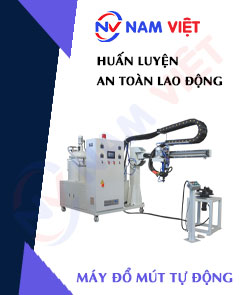
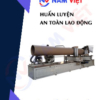
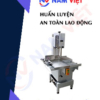



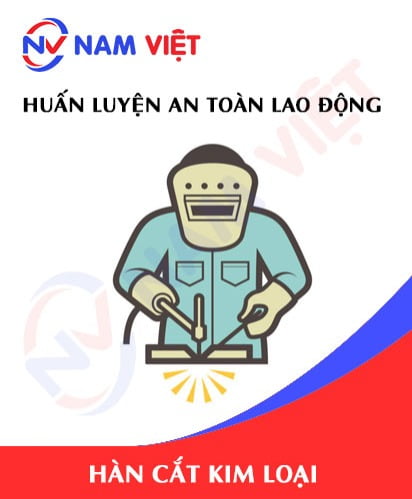



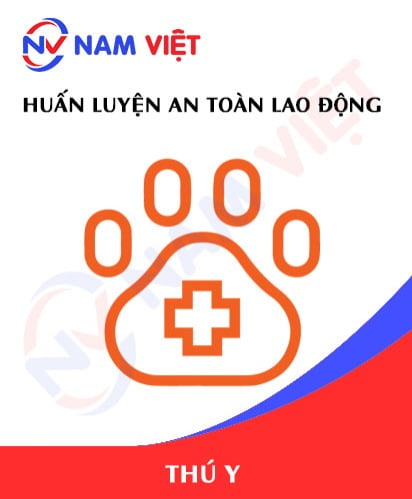



Review Occupational Safety Training for Automatic Foam Pouring Machine Operation
There are no reviews yet.